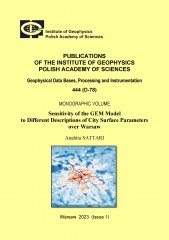- A - Physics of the Earth's Interior
- B - Seismology
-
C - Geomagnetism
C-119, C-118, C-117, C-116, C-115, C-114, C-113, C-112, C-111, C-110, C-109, C-108, C-107, C-106, C-105, C-104, C-103, C-102, C-101, C-100, C-99, C-98, C-97, C-96, C-95, C-94, C-93, C-92, C-91, C-90, C-89, C-88, C-87, C-86, C-85, C-84, C-83, C-82, C-81, C-80, C-79, C-78, C-77, C-76, C-75, C-74, C-73, C-72, C-71, C-70, C-69, C-68, C-67, C-66, C-65, C-64, C-63, C-62, C-61, C-60, C-59, C-58, C-57, C-56, C-55, C-54, C-53, C-52, C-51, C-50, C-49, C-48, C-47, C-46, C-45, C-44, C-43, C-42, C-41, C-40, C-39, C-38, C-37, C-36, C-35, C-33, C-32, C-31, C-30, C-29, C-28, C-27, C-26, C-25, C-24, C-23, C-22, C-21, C-20, C-19, C-18, C-17, C-16, C-15, C-14, C-13, C-12, C-11, C-10, C-9, C-8, C-7, C-6, C-5, C-4, C-3, C-2, C-1
-
D - Physics of the Atmosphere
D-79, D-78, D-77, D-76, D-75, D-74, D-73, D-72, D-71, D-70, D-69, D-68, D-67, D-66, D-65, D-64, D-63, D-62, D-61, D-60, D-59, D-58, D-57, D-56, D-55, D-54, D-53, D-52, D-51, D-50, D-49, D-48, D-47, D-46, D-44, D-45, D-43, D-42, D-41, D-40, D-39, D-38, D-37, D-35, D-34, D-33, D-32, D-31, D-30, D-28, D-27, D-26, D-25, D-24, D-23, D-22, D-21, D-20, D-19, D-18, D-17, D-16, D-15, D-14, D-13, D-12, D-11, D-10, D-9, D-8, D-7, D-6, D-5, D-4, D-3, D-2, D-1
- E - Hydrology
- P - Polar Research
- M - Miscellanea
-
Online First
Sensitivity of the GEM Model to Different Descriptions of City Surface Parameters over Warsaw
Volume: 444
Series: D-78
DOI: 10.25171/InstGeoph_PAS_Publs-2023-001
Over half of the world’s population lives in urban areas, even though urban agglomerations cover only 0.05% of the Earth’s surface. Urbanisation significantly modifies the surface level’s moisture, radiation balance, thermal stability, and aerodynamic properties. The physical processes in the urban surface layer directly influence the atmosphere above and, specifically, the atmospheric boundary layer. Thus, understanding and modelling these processes are necessary for studying the urban meteorology.
The primary objective of the presented research was to assess the impact of the urban land cover on the development of the atmospheric boundary layer over Warsaw. To carry out the objective, a high-resolution version of the Global Multiscale Environmental model was used to examine its ability to reproduce the diurnal cycle of the meteorological parameters, including the thermal and turbulent structure of the atmosphere. The Town Energy Balance (TEB) parameterisation was used to represent urban effects on modelled meteorological parameters at the final nesting level with a horizontal resolution of 1 km over Warsaw. Mid-high buildings, sparse buildings, industrial areas, roads and parking spaces, and a mix of built and nature are the urban cover categories used in the TEB parameterisation. Four one-day cases representing different meteorological conditions and seasons were selected for modelling.
MONOGRAPHIC VOLUME
C O N T E N T S
Editorial note, ...3
Acknowledgements, ...3
List of symbols, ...4
List of abbreviations, ...4
Abstract, ...5
Streszczenie, ...6
1. Introduction, ...7
1.1 Urbanisation, ...7
1.2 The study area – Warsaw, ...8
1.3 An outline of chapters, ...8
2. Literature review and background, ...8
2.1 Urban surface, ...9
2.1.1 Urban canyon, ...9
2.1.2 Sky view factor, ...9
2.2 Local climate zones, ...9
2.3 Atmospheric boundary layer, ...10
2.3.1 Urban boundary layer, ...11
2.3.1.1 The difference between the urban and rural boundary layers, ...11
2.3.1.2 The urban canopy layer, ...12
2.4 Surface energy balance, ...12
2.5 Urban heat Island, ...13
2.6 Urban canopy models, ...14
2.6.1 The town Energy balance (TEB) model, ...15
2.7 Sensitivity analysis for urban climate simulations, ...16
3. Data and methods, ...18
3.1 The GEM Model, ...18
3.2 Target area – the city of Warsaw, ...18
3.3 CORINE Land Cover (CLC), ...19
3.4 Urban modeling description and the TEB parameterisation, ...20
3.4.1 The land surface of Warsaw, ...22
3.5 GEM Model set up, ...22
3.5.1 Modelling scenarios, ...23
3.5.2 Sensitivity analysis, ...25
3.6 Model output, ...25
3.7 Meteorological conditions, ...25
3.7.1 January 29, 2010, ...25
3.7.1.1 April 24, 2010, ...26
3.7.1.2 June 6, 2010, ...27
3.7.1.3 July 23, 2010, ...27
3.8 Observational data, ...28
3.8.1 Vertical profiles evaluation with soundings, ...29
4. Results and discussion, ...30
4.1 Boundary layer analysis, ...30
4.1.1 C1 – Winter case, ...30
4.1.2 C2 – Spring case, ...36
4.1.3 C3 – Late spring case, ...40
4.1.4 C4 – Summer case, ...43
4.2 Sensitivity analysis, ...48
4.2.1 Air temperature, ...48
4.2.1.1 Surface temperature, ...50
4.2.2 Specific humidity, ...53
4.2.3 Precipitation rate, ...55
4.2.4 Turbulent kinetic energy, ...58
4.3 Statistical evaluation – forecast pereformance, ...61
4.3.1 Sounding profiles from Legionowo station, ...67
5. Conclusions and future work, ...71
5.1 Conclusions, ...71
5.2 Future work, ...73
References, ...74


